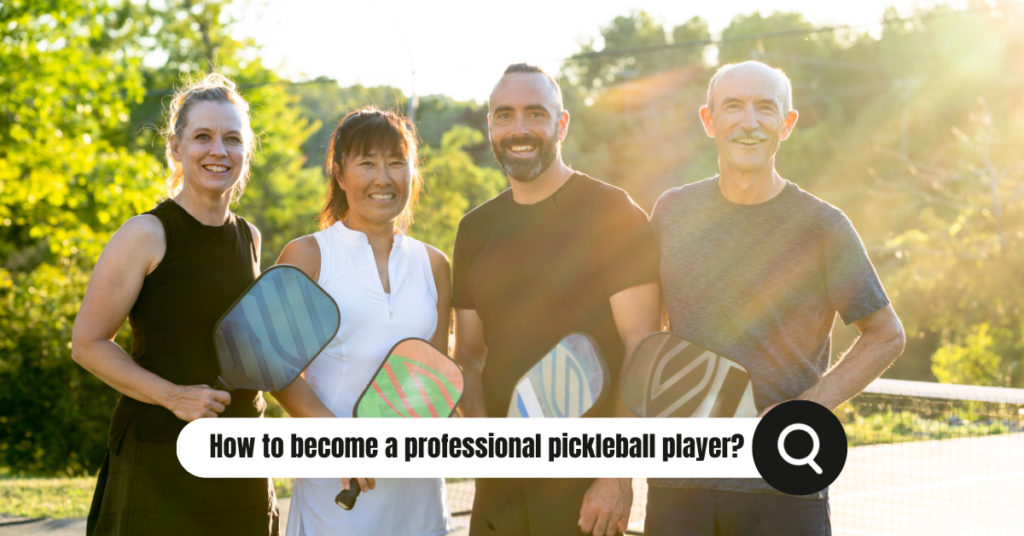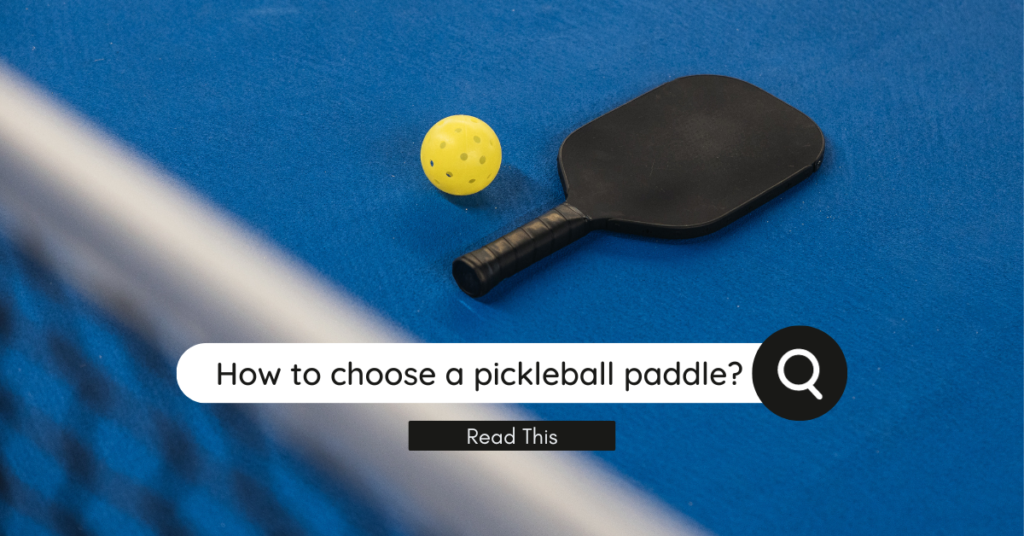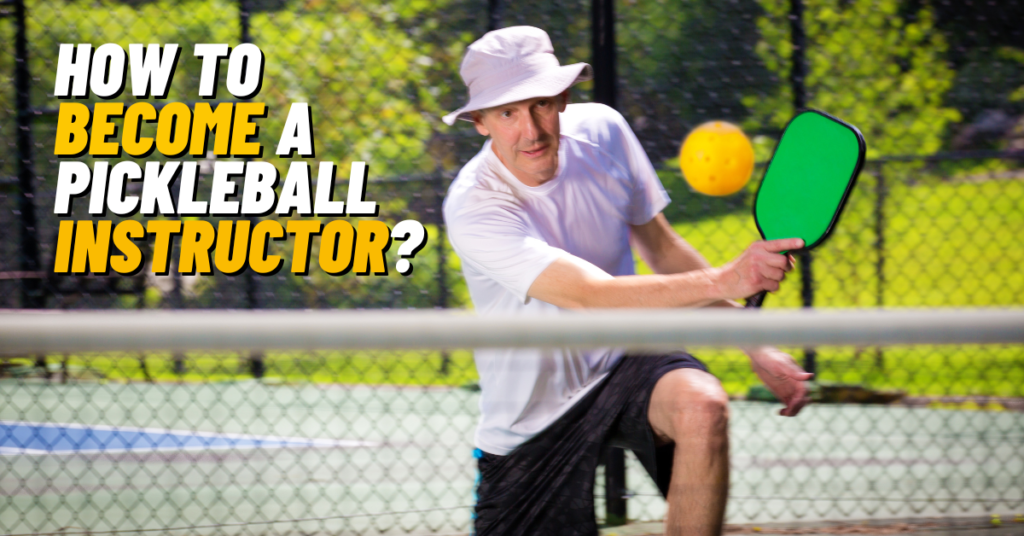Yes! you are in the right place, after reading this single article I am pretty sure that you will be clear about how to become a professional pickleball player all the way
The Basics Of Pickleball
Pickleball has gained tremendous popularity in recent years, attracting players of all ages and skill levels. This fun and fast-paced sport is a combination of tennis, badminton, and ping pong, played with a paddle and a plastic ball on a court similar to a tennis court. If you’re looking to dive into the world of pickleball and become a professional player, it’s important to understand the game and its rules, as well as develop the necessary skills and physical fitness required to excel in this exciting sport.
Understanding The Game And Its Rules
Before you start your journey to becoming a professional pickleball player, it’s crucial to have a solid understanding of the game and its rules. Here are some key points to keep in mind:
- Pickleball can be played as a singles or doubles game, with each player using a paddle to hit the ball over the net.
- The game is played on a court that measures 20 feet wide and 44 feet long for doubles, and 20 feet wide and 22 feet long for singles.
- The serving team starts the game by serving the ball diagonally to the opponent’s court, and the receiving team must let the ball bounce once before returning it.
- Once the ball is in play, both teams must let it bounce once before hitting it, and after that, either team can hit the ball before or after it bounces.
- The ball must stay within the boundaries of the court, and players must avoid stepping into the non-volley zone, located next to the net, unless the ball has already bounced in that zone.
- Points are scored when the serving team wins a rally, and the first team to reach 11 points (with a lead of at least two points) wins the game.
Necessary Skills And Physical Fitness Requirements
To succeed as a professional pickleball player, it’s essential to develop the necessary skills and maintain a high level of physical fitness. Here are some key skills and fitness requirements:
| Skills | Physical Fitness Requirements |
| Strong hand-eye coordinationAccurate and powerful shotsEffective communication and teamwork (for doubles)Quick reflexesStrategic thinking and decision makingAdaptability to different playing styles | Endurance and stamina for long matchesAgility and speed to cover the courtFlexibility and balance for quick movementsStrength and power for shots and net play |
Developing these skills and staying physically fit requires regular practice and training. It’s important to focus on both technical skills, such as shot accuracy and footwork, as well as physical conditioning, including cardiovascular exercises, strength training, and flexibility exercises. By dedicating time and effort to honing your skills and improving your physical fitness, you’ll be well on your way to becoming a professional pickleball player.
Starting Your Pickleball Journey
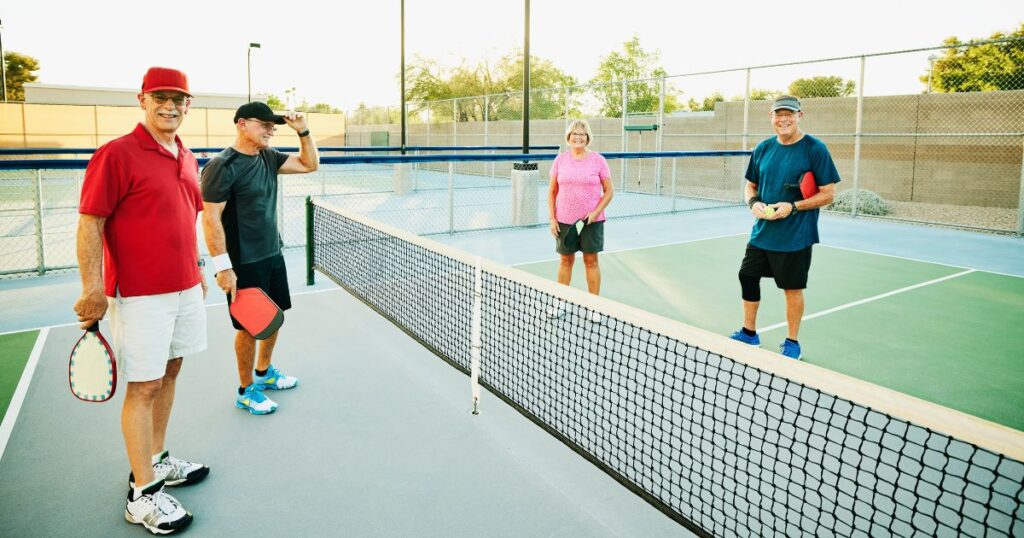
Embarking on a pickleball journey can be both exciting and intimidating. Whether you are a complete beginner or have some experience, developing the necessary skills and finding the right resources is essential. To help you get started, this article will guide you through important steps in your pickleball journey. From choosing the right equipment and attire to finding suitable pickleball courts, we have got you covered. Let’s dive right in!
Choosing The Right Equipment And Attire
When it comes to pickleball, having the right equipment and attire is crucial in enhancing your performance and maintaining comfort during gameplay. Here are a few key factors to consider:
1. Pickleball Paddle:
Your choice of pickleball paddle can greatly impact your gameplay. Remember to choose one that suits your playing style and skill level. A paddle with a comfortable grip, lightweight design, and suitable playing surface is an ideal choice. Additionally, keep in mind the paddle’s material, as it can affect the overall feel and control.
2. Pickleball Balls:
Investing in high-quality pickleball balls is essential for a reliable and consistent game. Opt for balls that are approved for competitive play and provide excellent bounce and durability. Most often, outdoor and indoor pickleball balls vary in terms of durability, so choose accordingly.
3. Attire:
Comfortable and appropriate attire can significantly impact your performance during a pickleball match. Consider wearing moisture-wicking clothing that allows ease of movement. Lightweight, breathable shoes with good traction can help prevent slips and falls on the court, ensuring optimal performance.
Finding A Suitable Pickleball Court
A suitable pickleball court is the foundation for developing your skills and enjoying the game. Here are some tips to help you find a court:
1. Local Recreation Centers:
Check with your local recreation centers as they often offer pickleball courts for public use. These facilities usually require a membership or reservation, but they provide well-maintained courts with the necessary amenities.
2. Parks and Community Centers:
Many parks and community centers are now incorporating pickleball courts due to the sport’s growing popularity. These spaces offer a more relaxed atmosphere and are great for connecting with other pickleball enthusiasts.
3. Online Pickleball Directories:
Utilize online pickleball directories to find nearby courts. These directories provide information regarding court locations, available playing times, and even reviews from other players. It’s an efficient way to explore different courts in your area.
In conclusion, starting your pickleball journey requires careful consideration of equipment and attire, as well as finding suitable court locations. By choosing the right gear and identifying accessible courts, you are on your way to becoming a professional pickleball player. So get ready to pickle, smash, and volley your way to success!
Developing Your Pickleball Skills
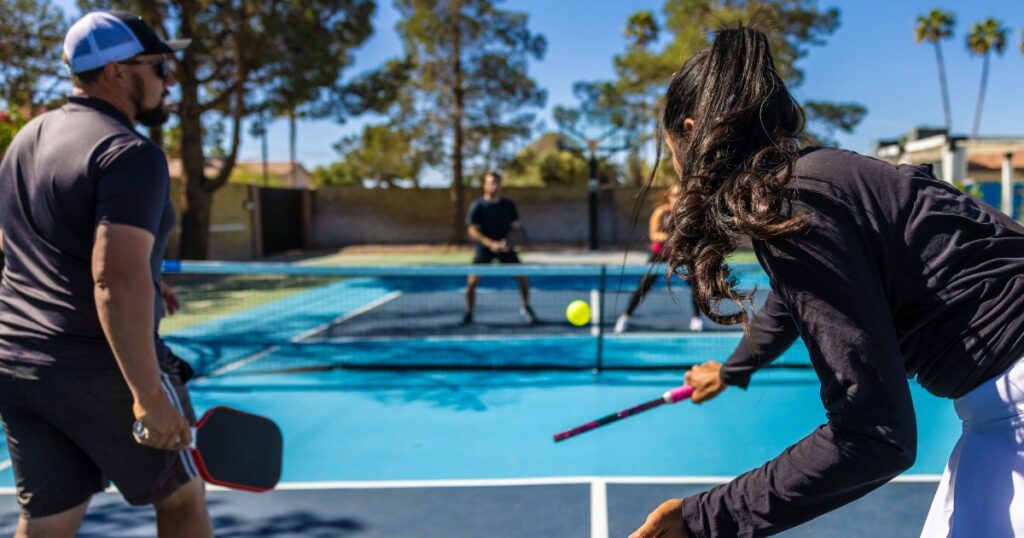
When it comes to becoming a professional pickleball player, skill development is key. To compete at a high level, it is essential to master the fundamental pickleball strokes and improve your footwork and agility. In this section, we will explore how you can elevate your pickleball game by focusing on these two crucial aspects.
Mastering The Fundamental Pickleball Strokes
Mastering the fundamental pickleball strokes is fundamental to becoming a professional player. These strokes are the building blocks of your game and include the serve, return of serve, dinks, volleys, and overhead smashes. By dedicating time and effort to honing these skills, you can enhance your overall performance on the court.
Here’s how you can work on perfecting these strokes:
- Begin with the serve: The serve is the starting point of every rally, making it crucial to have a reliable and strategic serve in your arsenal. Practice different serve techniques, such as the deep serve, short serve, and wide serve, to keep your opponents on their toes.
- Focus on return of serve: The return of serve is your chance to put pressure on your opponent from the very beginning. Develop different return strategies, such as the lob return or the aggressive drive return, to keep your opponent guessing and gain an early advantage.
- Perfect your dinks: Dinking is a delicate and precise technique that involves softly hitting the ball over the net. Work on your dinks to develop control, touch, and accuracy. Practice different dinking angles and heights to keep your opponents off-balance.
- Enhance your volleys: Volleys are crucial in pickleball, as they allow you to take control of the net and put pressure on your opponents. Focus on your timing, hand-eye coordination, and technique to improve your volley skills. Practice drills that simulate game situations to develop your reflexes and decision-making abilities.
- Excel at overhead smashes: The overhead smash is a powerful offensive shot that can put your opponents on the defensive. Work on your footwork and timing to position yourself correctly for the smash. Practice hitting smashes with power and precision to make them an effective weapon in your game.
Improving Your Footwork And Agility
In addition to mastering the pickleball strokes, improving your footwork and agility is crucial for success on the court. Fast and efficient footwork allows you to reach shots quickly, maintain balance, and be in the best position for every shot.
Here are some ways you can enhance your footwork and agility:
- Engage in specific footwork drills: Incorporate drills that focus on lateral movements, quick direction changes, and explosive starts and stops. These drills will help you develop agility, speed, and coordination.
- Work on your lateral movement: Lateral movements are essential in pickleball, as they enable you to cover the court efficiently. Practice shuffling side to side and moving quickly to reach shots in both the forehand and backhand directions.
- Improve your reaction time: Quick reactions are crucial in pickleball to respond swiftly to your opponent’s shots. Train your reflexes by practicing reaction drills that involve responding to various shots, such as volleys, lobs, and dinks.
- Strengthen your core and lower body: A strong core and lower body provide a solid foundation for improved footwork and agility. Incorporate exercises such as squats, lunges, and planks into your fitness routine to enhance your strength and stability on the court.
By dedicating time to mastering the fundamental pickleball strokes and improving your footwork and agility, you can take significant steps towards becoming a professional pickleball player. Remember, consistent practice and a focused mindset are essential for continuous growth and success in the sport.
Strategy And Tactics In Pickleball
Strategy and tactics play a crucial role in becoming a professional pickleball player. While mastering the fundamentals is essential, having a sound game plan and the ability to adapt to different situations can give you a competitive edge on the court. In this section, we will explore two key aspects of strategy and tactics in pickleball: understanding different playing styles and positions, and developing effective shot selection and placement.
Understanding Different Playing Styles And Positions
When it comes to pickleball, each player has their own unique style of play. Understanding the various playing styles can help you anticipate your opponent’s moves and adjust your strategy accordingly. Here are some common playing styles you might encounter:
- The Power Player: This player relies on strong shots and aggressive play to dominate the game. They often look for opportunities to overpower their opponents with hard-hit shots, aiming to force errors or create openings.
- The Dinker: Unlike the power player, the dinker focuses on finesse and precision. They employ soft shots and low, strategic dinks to wear down their opponents and force mistakes. Their goal is to maintain control of the game and keep their opponents off balance.
- The All-Rounder: This player excels in both power and finesse. They have a balanced approach to the game and can adapt their style based on the situation. All-rounders possess a mix of power shots and delicate touch, making them unpredictable and challenging to play against.
Furthermore, understanding the different positions in pickleball can also help you strategize better. The three primary positions are:
- The Server: The server has the advantage of starting every point. Serving strategically, targeting weaknesses, or exploiting opponents’ tendencies can set the tone for the entire game.
- The Net Player: Playing close to the net, the net player has an excellent opportunity to volley and dictate the pace of the game. They often look for opportunities to intercept and put pressure on their opponents with quick reflexes and sharp shots.
- The Baseline Player: Positioned near the back of the court, the baseline player focuses on maintaining a strong defensive position. They are skilled in rallying and defending against powerful shots, waiting for an opportunity to counterattack.
Developing Effective Shot Selection And Placement
Shot selection and placement are crucial skills that professional pickleball players master. Making wise choices about which shot to play and where to place it can help you outsmart your opponents and gain the upper hand. Here are some factors to consider:
- Opponent’s positioning: Analyze your opponent’s position on the court and look for gaps or weaknesses in their defense. Aim to exploit these areas by strategically placing shots that force them out of position or put them under pressure.
- Your own strengths: Identify your strengths as a player and utilize them to your advantage. If you possess excellent volleys, focus on getting to the net and capitalizing on opportunities. If your strengths lie in powerful groundstrokes, target your shots to keep your opponents on their heels.
- Situational awareness: Be aware of the score, game situation, and momentum. Adjust your shot selection based on these factors. For example, if you are leading in the game, you may choose to play a conservative shot and maintain control rather than taking unnecessary risks.
- Shot variation: Keep your opponents guessing by incorporating a variety of shots into your game. Mixing up the pace, angle, and spin can make it difficult for your opponents to anticipate your next move, forcing them into defensive positions and creating opportunities for you to attack.
Remember, practice and experience are key to honing your strategy and tactics in pickleball. Always be open to learning, observing top players, and adapting your game to different opponents and situations. By understanding different playing styles, positions, and developing effective shot selection and placement, you can elevate your pickleball game to a professional level.
Training And Conditioning For Pickleball
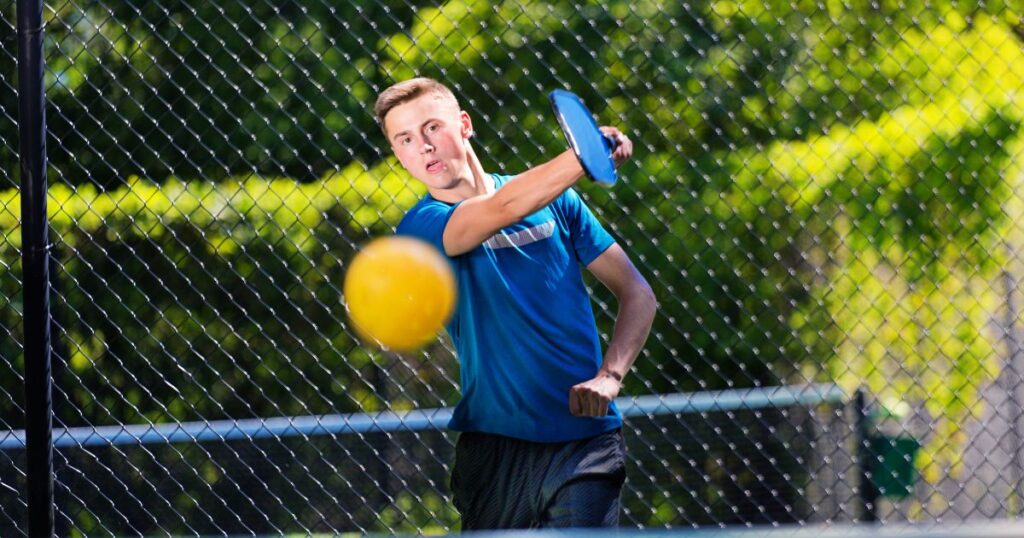
Training and conditioning play a vital role in becoming a professional pickleball player. To reach the top level of this fast-paced and action-packed sport, you need to focus on developing your physical abilities, improving your strength, endurance, and agility, and designing a personalized training plan that suits your individual needs. In this section, we will explore the key components of training and conditioning for pickleball and provide you with practical insights to help you elevate your game.
Designing A Personalized Training Plan
When it comes to training for pickleball, one size does not fit all. Each player is different and has unique strengths and weaknesses. Therefore, it’s essential to design a personalized training plan that caters to your specific needs and goals. To get started, consider the following factors:
- Assess your current fitness level: Before diving into a training program, assess your current fitness level. Identify your strengths and areas that need improvement, such as speed, power, or agility.
- Set specific goals: Determine what you want to achieve through your training. Whether it’s improving your performance on the court, increasing your endurance, or building strength, setting specific and achievable goals will help you stay focused and motivated.
- Consult with a professional: Seek guidance from a qualified coach or trainer who specializes in pickleball or other racket sports. They will help you develop a training plan tailored to your abilities and objectives.
Incorporating Strength, Endurance, And Agility Exercises
Improving your strength, endurance, and agility is crucial to excel in pickleball. A well-rounded training program should include exercises that target each of these areas. Here are some exercises to consider incorporating into your routine:
| Strength | Endurance | Agility |
| Bench pressSquatsLunges | CyclingRunningHigh-intensity interval training (HIIT) | Ladder drillsSide shufflesCone drills |
Remember to gradually increase the intensity and difficulty of your exercises to avoid injuries and maximize your improvement. Additionally, incorporating sport-specific drills into your training, such as practicing pickleball shots and footwork, will help you hone your skills for on-court success.
By designing a personalized training plan and incorporating exercises that target your strength, endurance, and agility, you can take your pickleball game to new heights. Remember, consistency and dedication are key, so put in the effort and watch yourself evolve into a professional pickleball player.
Mental Skills And Mindset In Pickleball
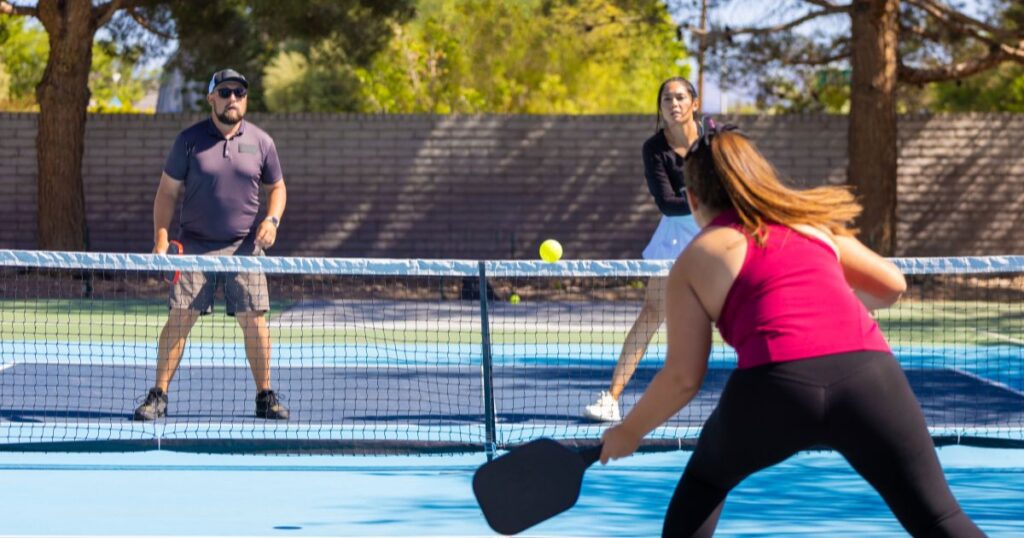
While pickleball is often considered a physically demanding sport, the mental aspect is equally crucial for success. Developing the right mental skills and mindset can make a significant difference in your performance on the court. In this section, we will explore two important aspects of mental skills and mindset in pickleball: developing focus and concentration during play, and handling pressure and coping with setbacks.
Developing Focus And Concentration During Play
In the fast-paced game of pickleball, maintaining focus and concentration is vital to staying competitive. Here are some effective strategies to enhance your concentration on the court:
- Eliminate distractions: Clear your mind and focus solely on the game. Your attention should be directed towards tracking the ball, anticipating your opponent’s moves, and strategically positioning yourself on the court.
- Create a pre-point routine: Establish a routine that helps you get into the right mindset before each point. This could involve taking deep breaths, visualizing successful shots, or repeating a personal mantra to stay focused.
- Practice mindfulness: Stay present in the moment by practicing mindfulness. Be aware of your surroundings, the sound of the ball, the feel of your paddle, and the movements of your body. This will help you stay in the zone and react quickly to changing game situations.
Handling Pressure And Coping With Setbacks
Pickleball can be a mentally challenging sport, especially when facing high-pressure situations or setbacks. To effectively handle pressure and bounce back from setbacks, consider the following strategies:
- Positive self-talk: Use positive affirmations to boost your confidence and maintain a positive mindset. Remind yourself of your skills, strengths, and previous successes to build resilience.
- Embrace adversity: Instead of viewing setbacks as failures, see them as opportunities for growth. Learn from your mistakes and use them as motivation to improve your game. Remember, even the best players face setbacks.
- Focus on the controllable: Shift your attention away from factors beyond your control, such as external distractions or your opponent’s performance. Instead, concentrate on the aspects of the game that you can control, such as your strategy, footwork, and shot selection.
- Take breaks: Sometimes, stepping away from the game for a short break can help reset your mindset. Use this time to relax, recharge, and visualize your success.
- Seek support: Surround yourself with a supportive community of fellow players, coaches, or mentors who can offer guidance and encouragement during challenging times. Their insights and perspective can be invaluable in maintaining a strong mental game.
By practicing these mental skills and cultivating the right mindset, you can enhance your performance as a pickleball player. Focus, concentration, and mental resilience are key ingredients for success on the court, allowing you to navigate pressure-filled situations and overcome setbacks with grace and determination.
Competing And Advancing In Pickleball
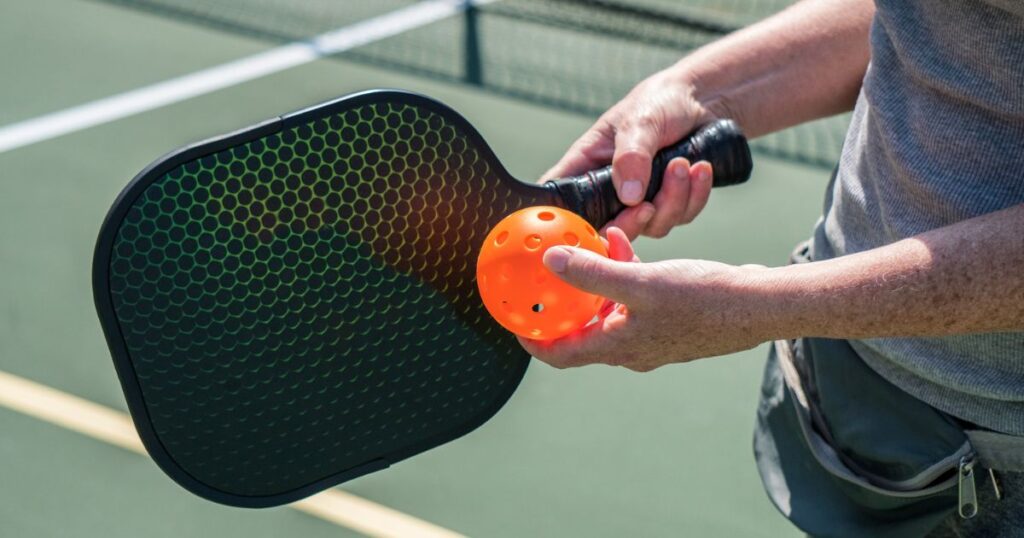
Learn how to carve your path to becoming a professional pickleball player and elevate your skills in the sport. Discover key strategies and tips to excel in the competitive world of pickleball.
Pickleball is a fast-growing sport that has gained immense popularity over the years. Whether you are a beginner or an experienced player, competing and advancing in pickleball is a key step towards becoming a professional player. In order to take your pickleball skills to the next level, it’s important to participate in tournaments and competitive events, as well as network and connect with the pickleball community.
Participating In Tournaments And Competitive Events
Participating in tournaments and competitive events is an essential aspect of advancing in pickleball. Tournaments provide players with the opportunity to showcase their skills, learn from experienced players, and gain valuable experience in a competitive setting.
When it comes to selecting a tournament to participate in, it’s important to consider your skill level. Start off by participating in local or regional tournaments that cater to players of all levels. These tournaments offer a great platform to gain exposure, understand the competitive landscape, and assess your own skills against other players.
As you gain more experience and improve your skills, you can then move on to larger and more prestigious tournaments. These tournaments often attract top-level players from around the world and provide an excellent opportunity to compete against the best in the sport.
Furthermore, it’s crucial to be consistent with your tournament participation. Regularly participating in tournaments will not only help you stay motivated and focused but also enable you to track your progress and identify areas for improvement.
Networking And Connecting With The Pickleball Community
Networking and connecting with the pickleball community is another important aspect of competing and advancing in the sport. The pickleball community is known for its welcoming and supportive nature, and building connections within the community can be highly beneficial.
One way to network within the pickleball community is to join pickleball clubs or organizations. These clubs often host regular events, such as round-robin tournaments or social sessions, which provide an ideal platform to meet and interact with fellow players, both casual and competitive.
| Benefits of Networking in the Pickleball Community: |
| Opportunities for practice matches and friendly games |
| Access to experienced players and mentors who can offer valuable guidance |
| Potential partnerships for doubles tournaments |
| Stay updated on upcoming tournaments and events |
Additionally, social media platforms dedicated to pickleball, such as online forums and Facebook groups, can be a great way to connect with the larger pickleball community. These platforms offer opportunities to ask questions, seek advice, and engage in discussions with players from different skill levels and backgrounds.
Networking and connecting with the pickleball community not only fosters a sense of belonging, but it also opens doors to various opportunities for growth and development as a player. By building relationships, you can expand your network, obtain valuable information, and create lasting connections within the pickleball community.
Frequently Asked Questions On How To Become A Professional Pickleball Player
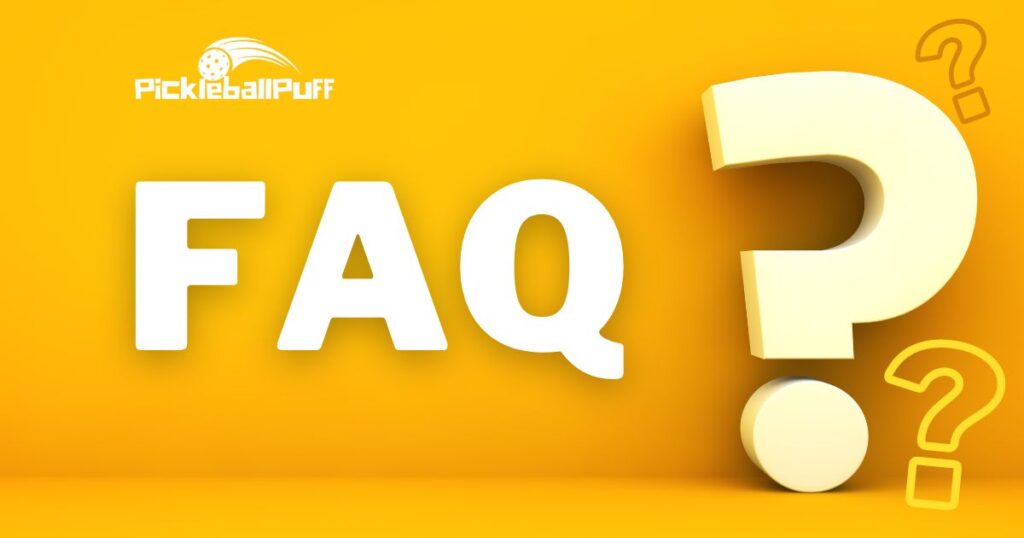
How Can I Become A Professional Pickleball Player?
To become a professional pickleball player, you need to master the game’s techniques, participate in local tournaments, and seek coaching from experienced players. Consistent practice, commitment, and a passion for the game are essential to succeed. Additionally, networking with other players and staying updated on pickleball strategies and trends can help improve your skills and increase your chances of becoming a pro.
What Are The Key Skills Required To Excel In Pickleball?
To excel in pickleball, you should focus on developing skills such as accuracy, agility, hand-eye coordination, court positioning, strategy, and effective shot placement. Becoming proficient in both forehand and backhand shots, understanding different grips, and having good reflexes are also crucial for success in this sport.
Are There Any Age Limits To Becoming A Professional Pickleball Player?
No, there are no age limits to become a professional pickleball player. Pickleball offers opportunities for players of all ages, from juniors to seniors. In fact, there are various age categories in tournaments that allow players to compete against others within their respective age groups, ensuring fair competition and equal opportunities for everyone to pursue a professional career in pickleball.
Conclusion
So, there you have it – a comprehensive guide on how to become a professional pickleball player. By following these steps, you can improve your skills, enhance your strategy, and compete at a higher level. Remember, consistency, dedication, and a passion for the sport will be your greatest allies on this journey.
So, grab your paddle, hit the court, and start your journey towards becoming a professional pickleball player today!

